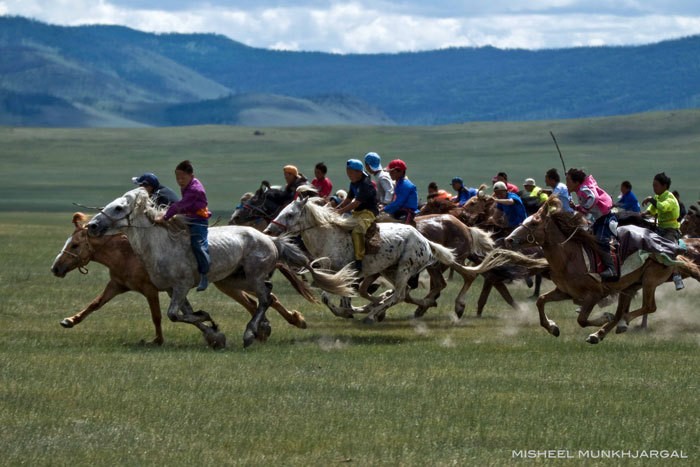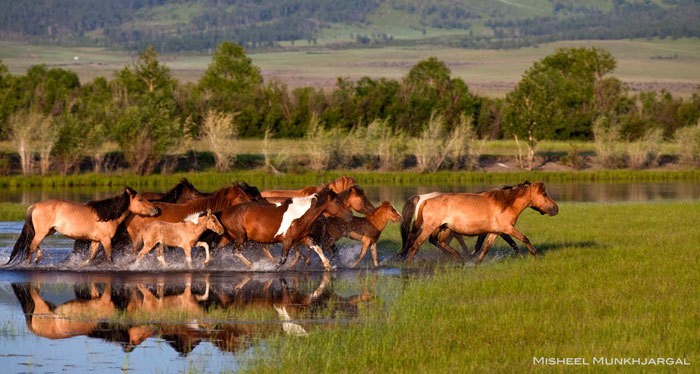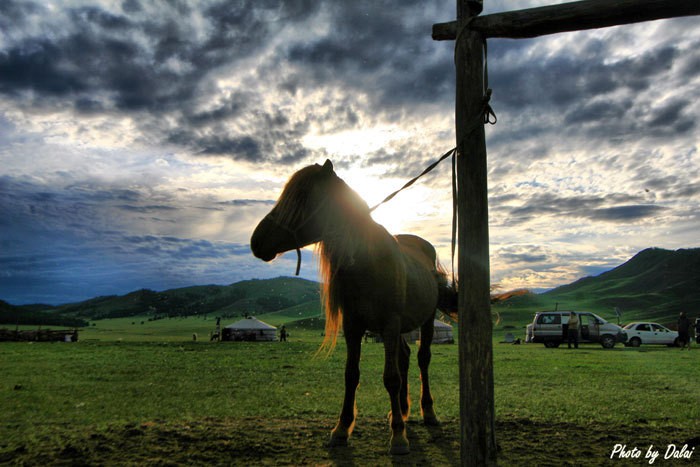 Mongolian horse racing is unique as it deeply reflects the nomadic culture and tests the Mongolian sturdy steeds in nature. The origin of the Mongol horse races starts thousands of years ago when the Mongol nomadic tribes competed with each other to see whose horses are the best from time to time. Hence, the nomads have perfected their techniques of horse training/racing and have passed the tacit knowledge from father to son over the centuries, so that the beautiful tradition still lives on.
Mongolian horse racing is unique as it deeply reflects the nomadic culture and tests the Mongolian sturdy steeds in nature. The origin of the Mongol horse races starts thousands of years ago when the Mongol nomadic tribes competed with each other to see whose horses are the best from time to time. Hence, the nomads have perfected their techniques of horse training/racing and have passed the tacit knowledge from father to son over the centuries, so that the beautiful tradition still lives on.
The Mongol style of horse training and racing commences with breeding as the fundament, which is nearly the half of the work. Legend says that some renowned horse trainers even used wild horse stallions to refine their own special horse breed in the olden days. The next step is selecting the race horses, trainers carefully hand-pick their steeds based on the horse physical features (and of course, the origin!). The Mongol horse trainers divide horses into several subgroups such as wolf-horse, moose-horse etc, and then each of the subgroups requires a different type of training. Nowadays, some trainers are mixing the pure Mongol breed with English, Arab and other breeds, and the Federation of Mongolian Horse Racing Sport and Trainers decided to organise separate races for the mixed breeds.


Race horses are trained from colt age, and racing distance varies for different age groups (depends on the season too). Horse racing venue is always the open steppes that Mongolia is famous for. And race horses first get registered at a spot then go to the starting line (which is some 10-25km depending on the horse ages), and finally starts from there to the finishing line – so in fact, the racing distance is doubled. Mongolian horses might look small in size but they have amazing stamina and are greatly strong, therefore, good for long distance rides.
Interestingly, the Mongolian horse jockeys are young boys and girls often aged between 5-12 years old, and today it’s causing controversy due to child right issues. Therefore, now there are regulations stating that all jockeys must be insured, and are required to wear riding helmets.
Great Naadam Festival 2016 horse racing schedule:
|
Dates |
Timing: |
Event |
Venue |
|
10 July:
|
08:00-11:00 |
4 y/o (khyazaalan) horse races |
Khui Doloon Khudag |
|
14:00-16:20 |
3 y/o (shudlen) horse races |
||
|
11 July |
08:00-11:40 |
Stallion races |
Khui Doloon Khudag |
|
14:00-17:00 |
Adult horse races |
||
|
12 July |
07:00-09:20 |
5 y/o (soyolon) horse races |
Khui Doloon Khudag |
|
10:30-12:30 |
2 y/o (daaga) races |
Prepared exclusively for GoGo Travel by Zola
(Co-founder of Premium Travel Mongolia. ww.mongoliatravelmarket.com)
Copyright © 2016. All rights reserved.
 Mongolian horse racing is unique as it deeply reflects the nomadic culture and tests the Mongolian sturdy steeds in nature. The origin of the Mongol horse races starts thousands of years ago when the Mongol nomadic tribes competed with each other to see whose horses are the best from time to time. Hence, the nomads have perfected their techniques of horse training/racing and have passed the tacit knowledge from father to son over the centuries, so that the beautiful tradition still lives on.
Mongolian horse racing is unique as it deeply reflects the nomadic culture and tests the Mongolian sturdy steeds in nature. The origin of the Mongol horse races starts thousands of years ago when the Mongol nomadic tribes competed with each other to see whose horses are the best from time to time. Hence, the nomads have perfected their techniques of horse training/racing and have passed the tacit knowledge from father to son over the centuries, so that the beautiful tradition still lives on.
The Mongol style of horse training and racing commences with breeding as the fundament, which is nearly the half of the work. Legend says that some renowned horse trainers even used wild horse stallions to refine their own special horse breed in the olden days. The next step is selecting the race horses, trainers carefully hand-pick their steeds based on the horse physical features (and of course, the origin!). The Mongol horse trainers divide horses into several subgroups such as wolf-horse, moose-horse etc, and then each of the subgroups requires a different type of training. Nowadays, some trainers are mixing the pure Mongol breed with English, Arab and other breeds, and the Federation of Mongolian Horse Racing Sport and Trainers decided to organise separate races for the mixed breeds.


Race horses are trained from colt age, and racing distance varies for different age groups (depends on the season too). Horse racing venue is always the open steppes that Mongolia is famous for. And race horses first get registered at a spot then go to the starting line (which is some 10-25km depending on the horse ages), and finally starts from there to the finishing line – so in fact, the racing distance is doubled. Mongolian horses might look small in size but they have amazing stamina and are greatly strong, therefore, good for long distance rides.
Interestingly, the Mongolian horse jockeys are young boys and girls often aged between 5-12 years old, and today it’s causing controversy due to child right issues. Therefore, now there are regulations stating that all jockeys must be insured, and are required to wear riding helmets.
Great Naadam Festival 2016 horse racing schedule:
|
Dates |
Timing: |
Event |
Venue |
|
10 July:
|
08:00-11:00 |
4 y/o (khyazaalan) horse races |
Khui Doloon Khudag |
|
14:00-16:20 |
3 y/o (shudlen) horse races |
||
|
11 July |
08:00-11:40 |
Stallion races |
Khui Doloon Khudag |
|
14:00-17:00 |
Adult horse races |
||
|
12 July |
07:00-09:20 |
5 y/o (soyolon) horse races |
Khui Doloon Khudag |
|
10:30-12:30 |
2 y/o (daaga) races |
Prepared exclusively for GoGo Travel by Zola
(Co-founder of Premium Travel Mongolia. ww.mongoliatravelmarket.com)
Copyright © 2016. All rights reserved.
